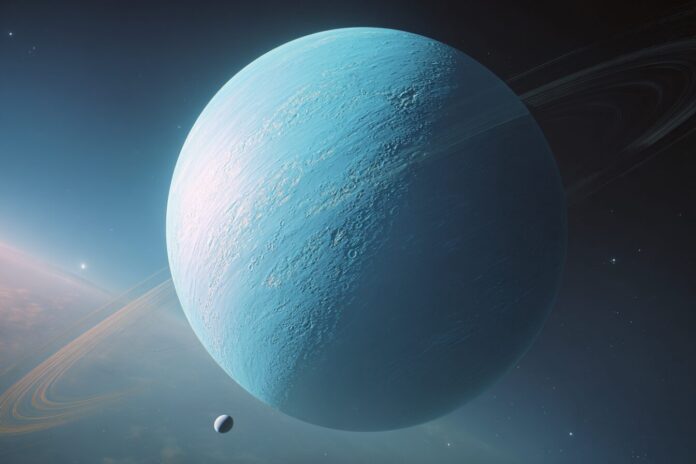NASA Webb’s Vision Expands Our Solar System’s Frontier
In a groundbreaking achievement for astronomy, scientists have discovered a minuscule new moon orbiting Uranus, expanding our understanding of the outer solar system. Most importantly, this discovery was made possible by the advanced capabilities of the James Webb Space Telescope (JWST), which is renowned for its infrared vision and precision. Because of JWST’s high sensitivity, even objects as small as this can now be detected, revealing the intricate details that older instruments could not uncover. This breakthrough not only enhances our catalog of celestial bodies but also highlights the continuous evolution of space exploration technology.
Furthermore, the Southwest Research Institute (SwRI) led the observational campaign that ultimately led to this exciting find. The newly discovered satellite, provisionally named S/2025 U1, measures about 6 miles (10 kilometers) in diameter, making it the smallest Uranian moon recorded to date. Such discoveries encourage scientists to revisit long-held models of planetary systems and propose fresh ideas about satellite formation. For additional insights on this historic discovery, one can refer to detailed reports on Space.com and NASA’s Webb blog.
Discovery Details: Innovative Methods Behind S/2025 U1
The precise discovery took place on February 2, 2025, during a series of ten 40-minute exposures captured by JWST’s Near-Infrared Camera (NIRCam). Because JWST observes in the infrared, it can penetrate the cosmic dust and uncover objects that are extremely faint, like S/2025 U1. Therefore, the use of such advanced techniques allowed astronomers to spot this elusive moon that had been overlooked in earlier missions, including the historic Voyager 2 flyby in 1986. Besides that, the integration of prolonged exposure times contributed to a clearer and more detailed image, underscoring JWST’s precision.
In addition to capturing raw images, scientists performed rigorous data analysis to confirm the presence and orbit of S/2025 U1. The moon orbits Uranus at roughly 35,000 miles (56,000 kilometers) from the planet’s center, a distance that provides new clues about the gravitational dynamics of Uranus’ satellite system. This method of discovery reflects modern practices in astronomical observation, where high-resolution imaging and detailed spectroscopic analysis work hand in hand to validate findings.
What Makes S/2025 U1 a Revolutionary Discovery?
Most importantly, S/2025 U1 stands out not only because of its diminutive size but also due to its faint display of reflectivity, which is similar to other small satellites orbiting Uranus. Because of this faint signal, previous missions could not detect it. Its nearly circular orbit implies that it most likely formed in situ, rather than being captured from elsewhere, providing insights into the formation of Uranus’ inner moons. Therefore, each observation plays a critical role in reconstructing the satellite’s origin and evolution. Detailed analyses by the team have underscored that its discovery prompts a re-examination of known formation models for moons in the outer regions of our solar system.
This discovery is highly significant because it suggests that the environment around Uranus is even more complex than previously thought. With a total of 29 known moons now, the intricate interplay between these satellites and the planet’s ring system continues to intrigue astronomers. Researchers are optimistic that further observations could reveal even more subtle components of this dynamic system, as noted by reports from the Southwest Research Institute and other scientific bodies.
Recent Images: A Closer Look at the New Moon
The JWST team has also released a series of visually stunning images that allow us to appreciate the discovery of S/2025 U1 in vivid detail. These images include composite visuals that juxtapose the new moon against thirteen of Uranus’ known satellites, with S/2025 U1 highlighted in yellow for easy identification. Because these images combine multiple exposures, they provide a layered view that reveals the delicate structure of Uranus’ rings and the diffuse glow of its atmosphere. For a visual treat, visit the image gallery on the ESA Webb site.
Furthermore, the infrared composites not only enhance the contrast between different celestial features but also illustrate the effective capabilities of modern imaging technology. These high-definition snapshots bolster our understanding of the satellite’s properties and its interactions within Uranus’ gravitational field. Consequently, the enhanced imagery stands as a tribute to the revolution in astrophotographic techniques spearheaded by JWST.
Implications for Future Uranus Exploration
The discovery of S/2025 U1 raises exciting prospects for future exploratory missions to the ice giant. Because every new observation opens a window into the past and future trajectories of planetary bodies, this finding underscores the need for further investigations into Uranus’ moons and ring dynamics. Most importantly, continued observations with JWST could reveal even more hidden satellites and uncover the origins of enigmatic ring structures. This may even result in significant shifts in our understanding of planetary system evolution.
In addition, astronomers believe that the Uranian system could be more complex than initially estimated. Therefore, this discovery fuels discussions about conducting targeted missions to Uranus, which would allow spacecraft to closely examine the planet’s atmospheric conditions, moon compositions, and potential interactions among these components. The potential to study these phenomena promises to yield invaluable data for both theoretical models and future exploratory missions.
Conclusion: A New Chapter in Outer Solar System Exploration
In conclusion, the discovery of the tiny new moon S/2025 U1 marks a monumental step forward in the field of astronomy. Because of the exceptional sensitivity of the James Webb Space Telescope, our ability to detect even the faintest objects has been profoundly enhanced. This achievement not only increases Uranus’ moon count to 29 but also challenges existing theories about planetary and satellite formation. Such discoveries reaffirm our belief that the cosmos is full of surprises waiting to be unveiled.
Moreover, as we celebrate this milestone, the scientific community is energized by the potential for further groundbreaking discoveries in the outer solar system. Therefore, the journey to uncover the secrets of Uranus and its numerous satellites continues with renewed vigor and anticipation. With every new observation, we are reminded that there is always more to learn about the vast universe we inhabit.



